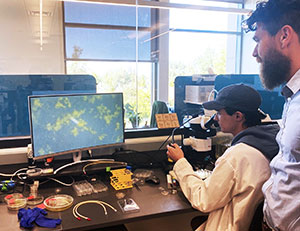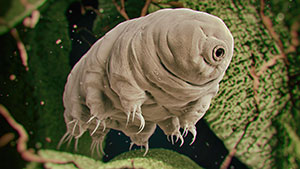
Contact Us
Institutional Communications
Bureau of Mines Building, Room 137
Laramie, WY 82071
Phone: (307) 766-2929
Email: cbaldwin@uwyo.edu
UWs Boothby Receives NASA Grant to Study How Hardy Organisms Cope With Radiation Exposure in Space
Published August 30, 2022

Thomas Boothby (right), a University of Wyoming assistant professor of molecular biology,
and Anthony Trent, a UW senior from Laramie majoring in molecular biology, work with
a tardigrade under the microscope that they can view on a computer screen. Boothby
recently received a nearly $100,00 NASA grant to study the effects of long-term radiation
on tardigrades and nematode worms in an effort to help better prepare astronauts for
space flight. (Vincent Nicholson Photo)
Thomas Boothby, a University of Wyoming assistant professor of molecular biology, recently received a nearly $100,00 NASA grant to study the effects of long-term radiation on tardigrades and nematode worms in an effort to help better prepare astronauts for space flight.
By studying how the tiny creatures cope with acute and chronic exposure to ionizing radiation, Boothby hopes to better understand the commonalities and differences between these types of exposures. This will allow NASA to better formulate safeguards, countermeasures and therapies for protecting astronauts, which Boothby says will be essential for fostering a safe and productive long-term human presence in space and supporting the United States’ space economy.
“During space flight, humans are no longer protected by Earth’s atmosphere and, therefore, are exposed to dramatically increased levels of radiation. This can have severe detrimental effects on our physiology and health,” Boothby says. “Most of the research that has been done with regard to the effects of radiation has looked at acute single exposures to radiation. But, of course, in space, astronauts do not experience just one single large dose. Rather, they must tolerate and cope with long-term chronic exposure to radiation.”
In 2020 and 2021, tardigrades from Boothby’s UW lab were part of an experiment on the International Space Station aimed at better understanding changes to their gene expression as they experienced stressful environments in space.
Now, tardigrades and nematode worms are being used because they provide unique insights into how animals can suffer from or cope with radiation, Boothby says.
“Nematode worms, like humans, are susceptible to radiation damage, while their cousins, the tardigrades, are one of the toughest organisms we know of when it comes to surviving high doses of radiation,” he says. “By using these two organisms, we will be able to see not only how acute or chronic radiation exposure negatively affects the biology of the worms, but we also will be able to gain insights into how tardigrades are able to combat the detrimental effects of these stresses.”

This illustration shows a tardigrade. (Shuttershock.com Photo)
Tardigrades are renowned for surviving a number of environmental stresses, including being dried out, frozen and heated to temperatures above the boiling point of water. They also can go for days or weeks with little or no oxygen; survive extremes in pressure, including the vacuum of outer space; and have been shown to survive up to 1,000 times as much radiation as typical animals and humans can.
“Because they are so tough, we expect that tardigrades will be able to mount protective or reparatory strategies to cope with both acute and chronic exposure to radiation,” Boothby says.
According to the grant proposal summary, the goal of the project is to understand how prolonged low-dosage exposure to ionizing radiation affects different biological systems at the level of genome integrity, gene expression, and developmental and reproductive biology.
“There are different types of radiation: ionizing and nonionizing. Ionizing radiation is much harsher and causes a lot of damage to biological systems,” Boothby explains. “Ionizing radiation also happens to be much more prevalent in space environments. We are using X-rays because they are a ready source of ionizing radiation and ultraviolet-C light because it is nonionizing. By using these different types of radiation, we will be able to see if nematodes and tardigrades are affected differently by these different types of radiation.”
The grant provides funding for one UW graduate student to help perform the experiments. While this position is not yet filled, Boothby says Anthony Trent, a UW senior from Laramie majoring in molecular biology, is already part of the grant research team.
“My role in the research is conducting some experiments pertaining to some of the aims of the grant, including experimentation about fractionated versus acute irradiation effects on tardigrades,” Trent says.
While no exact dates are set, Boothby expects the grant to start this October and run through September 2023.
Contact Us
Institutional Communications
Bureau of Mines Building, Room 137
Laramie, WY 82071
Phone: (307) 766-2929
Email: cbaldwin@uwyo.edu
